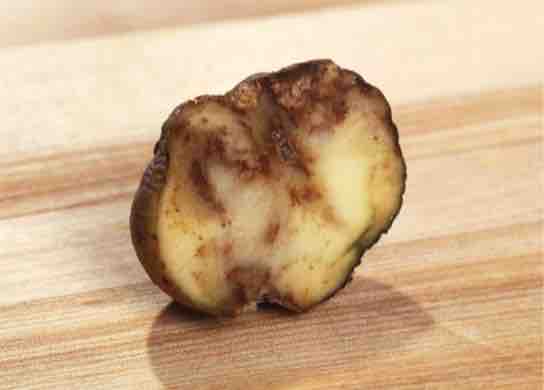Plant Parasites
Protist parasites prey on terrestrial plants and include agents that cause massive destruction to food crops. The oomycete Plasmopara viticola parasitizes grape plants, which causes a disease called downy mildew . Grape plants infected with P. viticola appear stunted and have discolored, withered leaves. The spread of downy mildew nearly collapsed the French wine industry in the nineteenth century. They are easily controlled once discovered, so careful monitoring of susceptible hosts is key because if left unaddressed, the organism can quickly spread and completely overwhelm the host species

Downy mildew
Both downy and powdery mildews on this grape leaf are caused by an infection of P. viticola.
Because the downy mildew pathogen does not overwinter in midwestern fields, crop rotations and tillage practices do not affect disease development. The pathogen tends to become established in late summer. Therefore, planting early season varieties may further reduce the threat posed by downy mildew. Fungicides can also be applied to control downy mildew. Broad spectrum protectant fungicides such as chlorothalonil, mancozeb, and fixed copper are somewhat effective in protecting against downy mildew infection.
Phytophthora infestans is an oomycete responsible for potato late blight. This disease causes potato stalks and stems to decay into black slime . Widespread potato blight caused by P. infestans led to the well-known Irish potato famine in the nineteenth century that claimed the lives of approximately one million people and resulted in the emigration of at least one million more from Ireland. Late blight continues to plague potato crops in certain parts of the United States and Russia, wiping out as much as 70 percent of crops when no pesticides are applied.

Potato Late Blight
These unappetizing remnants result from an infection with P. infestans, the causative agent of potato late blight.
Agents of Decomposition
The fungus-like protist saprobes are specialized to absorb nutrients from non-living organic matter, such as dead organisms or their wastes. For instance, many types of oomycetes grow on dead animals or algae. Saprobic protists have the essential function of returning inorganic nutrients to the soil and water. This process allows for new plant growth, which in turn generates sustenance for other organisms along the food chain. Indeed, without saprobe species, such as protists, fungi, and bacteria, life would cease to exist as all organic carbon became "tied up" in dead organisms.